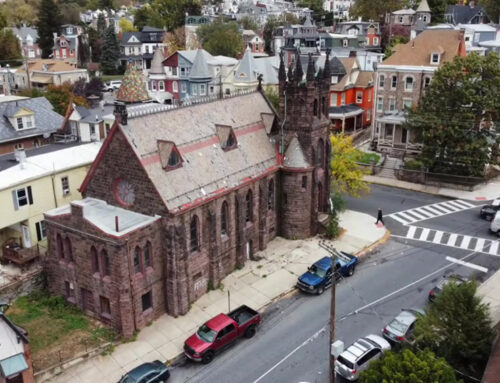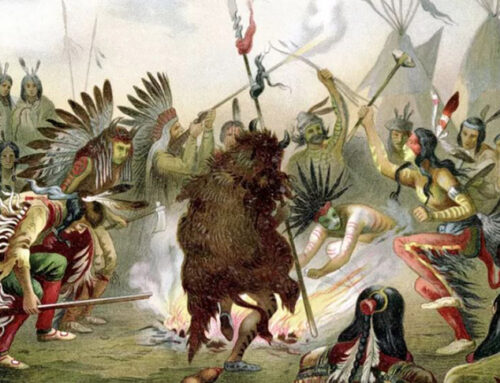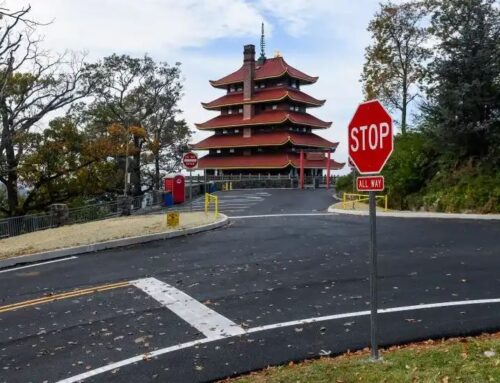The town of Reading was chartered as a borough by the Pennsylvania General Assembly in 1783, and granted a new Borough Charter in 1813, with the legal boundaries set beyond those of the original town plan. The northern and southern boundaries were still determined by 70-degree-angle estate lines: the northern boundary ran along Lardner’s Lane, of which remains only West Douglass Street and the two and three-hundred blocks of Robeson Street. These boundaries remained until long after Reading became a City in 1847. Within this short period Reading rapidly prepared to become a city. Along with the rest of the Nation, Reading became more of a manufacturing center and soon saw the introduction of heavy industry with the birth of steam power. Population rose from about 3,500 in 1813 to 13,000 in 1847. Around 1813 the town plan was altered to provide for the emergence of streets to the north and south of the original layout: chief among these were Buttonwood, Elm, Spruce, Pine, Laurel, Willow, Canal and South Streets. These were planned according to the original scheme of dimensions for streets. During this period Reading’s residential development was most affected by the Borough’s industrial expansion.
After the Revolution, America began to develop its hinterland for its abundant resources. Philadelphia was the largest city in the Nation at that time, and played a large role in the economic lives of the towns of eastern and central Pennsylvania, which supplied agricultural products and raw manufacturing materials. An increasing quantity of agricultural products and furs was sent to Philadelphia via the Schuylkill River, and the discovery of coal in these areas by 1820 required improvements in the transportation network to Philadelphia. Reading realized its potential as a key link in this network, and quickly initiated these improvements.
The old main roads were improved by the Commonwealth and were more heavily traveled, and hotels, blacksmith shops, taverns, and other establishments necessary to travelers sprang up along the Reading/Perkiomen/Philadelphia Turnpike, the Harrisburg Pike, the Lancaster Pike, the Pottsville Pike, the Pricetown Road and the Kutztown Road. Roads such as First Hockley Lane, Second Hockley Lane (West Greenwich Street remains) and Lardner’s Lane became more important as the outlying estates were divided into ever-smaller sections. Bridges began to appear across the Schuylkill to cope with increased use of roads, where before there had been ferries or nothing. A wooden bridge at the foot of Penn Street was completed about 1816. A chain bridge at Kissinger’s Mill (near the present Schuylkill Avenue Bridge) which had been constructed in 1810, was replaced with a wooden bridge in 1830 for the convenience of travel to and from the northwest townships. The establishment of this bridge led to heavier use of the roads which led from the bridge to the town: Kissinger’s Lane, which now exists as Schuylkill Avenue, and Coaler’s Lane, which was parallel to it and to the east and is no longer in existence. In 1831 the ferry serving the Lancaster Pike was replaced with a bridge, bringing increased traffic to Bingaman Street.
Below: Old covered Lancaster Ave. bridge looking towards Neversink mountain. The bridge burned in 1876. On the right of the photo next to the pier is the old cattle towpath used by the Union Canal. The old road on the right is now under the West Shore bypass.

The construction of the canals at this time greatly increased Reading’s commercial possibilities and aided in transportation. Reading was seen as a convenient half-way point on the line of canals, which linked the Susquehanna with the Delaware. Both the Schuylkill and Union Canal Companies operated out of Reading. The Schuylkill Canal was completed in 1825, and the entire route from Philadelphia to Middletown by way of Reading was operational by 1828. The Schuylkill Canal, which ran along the eastern bank of the river, was enlarged to hold larger vessels in 1832 and again in 1846, and proved an invaluable asset to the Borough’s manufacturing interests.
Below: Photo, taken by Dr. William A. Haman in 1899, looks northward from the Franklin Street Guard Lock. It shows the Schuylkill Canal running beneath the 1884-1914 Penn Street Bridge. Notice the roofline of the Pennsylvania Railroad depot, which was greatly altered when the present Penn Street Viaduct was constructed.

The construction of a short railroad line in an area farther along the Schuylkill where a canal was impossible clearly illustrated how much more efficient and economical the railroads could be for the Eastern Pennsylvania/Philadelphia network, and within a decade of the construction of the canals, construction of a railroad for Reading was underway. The Philadelphia and Reading Railroad Company was incorporated in 1833 and work at Reading was begun immediately. By 1837 a single track was completed from Reading to Pottstown, and regular rail steam service began one year later. Service was extended from Reading to Philadelphia in 183‘), and from Pottsville to Philadelphia in 1841.
The Philadelphia and Reading Railroad was granted eminent domain in the laying of its track which meant that there were very few restrictions as to where the railroad line could run. Naturally, the engineers would choose the line of least resistance. Rather than running the track along the west end of Reading, where it would interfere with the canal and have to cope with the frequent flooding of the Schuylkill, the railroad officials chose to place the line at the other end of town. The track, then, ran along the base of Mt. Neversink approaching the Borough from the south; then ran northward along Seventh Street, which was, at that time, the eastern edge of the developed town: and then continued northward through a valley between Mt. Penn and the river, running alongside the old Kutztown Road for about a mile before continuing on to Pottsville. This route covered some passably level territory and (at that time) avoided running through the middle of Reading.
The first station house was erected at Seventh and Cherry in 1836, and was followed one year later by a locomotive and steam engine factory on Canal Street above Third. In 1839, a deep cut was made for the tracks between Penn and Walnut Streets which allowed the trains to run beneath bridges at Liberty Alley (now Court Street), Washington and Walnut Streets. Through the 1840’s, new railroad shops and a depot were constructed nearer to the tracks, on Seventh Street between Franklin and Bingaman Streets. This was a more convenient location both for the operation of the railroad and for the employees of the shops, who lived in houses which were built nearby and were a major cause for the swift development of that part of South Reading.
Southwest Reading was the first area beyond the original town plan to be developed. It had no sharp inclines or other geographical obstructions as did the other sections; it had plenty of fresh water, and most importantly, it had the canal and the railroad. The earliest heavy industries established at this time were railroad related, but very soon manufactories were locating in Reading because of its proximity to both Philadelphia and to natural resources, and not because they needed the railroad to buy their products.
Moreover, many of Reading’s early industries were established as very small operations by Reading residents, who later discovered the benefits of their locations and expanded. In turn, the birth of these industries led to the development of residential neighborhoods for the growing labor force.
The Borough’s first establishment for heavy manufacturing, Reading Iron and Nail Works, appeared at the foot of Seventh Street, near to both the canal and the railroad, in 1836. Begun as a rolling mill and nail factory, it employed 250 workers. Its operations and employee rolls expanded rapidly, and in 1846 the name changed to Seyfert, McManus and Company. In 1840 two large iron related establishments were founded: the Henry Clay Anthracite Furnace southeast of Reading Iron and Nail near the railroad, and the Franklin Foundry at Eighth and Chestnut Streets. The Franklin expanded to become a railroad car manufactory in 1844. Other operations which were in existence in the Southwest by 1847 included: the Darling Foundry and Machine Shop at Third and Canal, the Union Canal Company, the Schuylkill Navigation Company, Jackson Rope Works at the foot of Bingaman Street, Reading Fire Brick Works at the foot of Fourth Street, other brickyards on Sixth and Eighth Streets between Chestnut and Spruce Streets, and the Lauer Brewery, which had been at Third and Chestnut since its establishment in 1826.
The rest of Reading was relatively sparse in heavy manufacturing at this time. There were three brickyards in the Northeast, and a brickyard and a distillery, as well as a rolling mill and an iron foundry on the canal near Washington Street, in the Northwest.
Most residential development between 1813 and 1847 occurred east of Seventh Street between Walnut and Chestnut, and south of Chestnut west of the railroad, the latter occurring largely because people wanted to live near their places of employment. Most of this growth took place during the late 1830’s and 1840’s: in 1837 scarcely anyone lived east of the railroad tracks. In 1817 the rise in population called for the division of the Borough into two election wards North Ward and South Ward – with their division at Penn Street. In 1840 a boundary along Sixth Street divided these two wards into four. And only four years later a fifth ward was created by subdividing the Southwest Ward at Spruce Street, to compensate for the rapid development of that area. In 1832 the grading of streets was begun (the old names were changed to suit Republican tastes in 1833), and in 1840 the heavily used streets were paved with a hard white gravel.
The face of the Borough was changing overnight. In addition to its industrial establishments, Reading was attempting to look more like a city with new residential and commercial buildings. Brick was the preferred building material and commercial leaders were encouraged to erect taller buildings. By 1840 Reading contained 1,365 buildings: 778 brick, 432 frame, and 155 log. In 1847, seventy buildings were constructed which were more than two stories high, while seven years earlier only 56 such buildings existed.
At this time, minority groups played little part in the directions of town development. Most new immigrants were Germans like the rest of the population, and found work in the industries and so lived in the newly developed areas. A small community of free Black families was being established in the extreme Northeast, in the neighborhood of Tenth and Washington, through the 1830’s and 1840’s. When Reading became a city in 1847, general development had just begun to reach that section.





